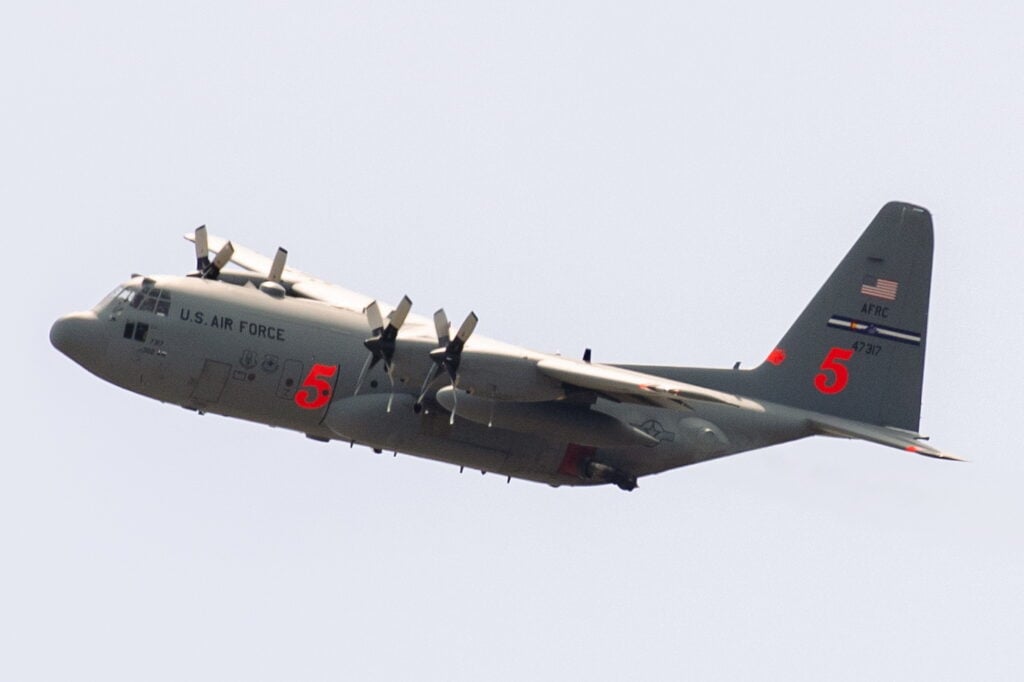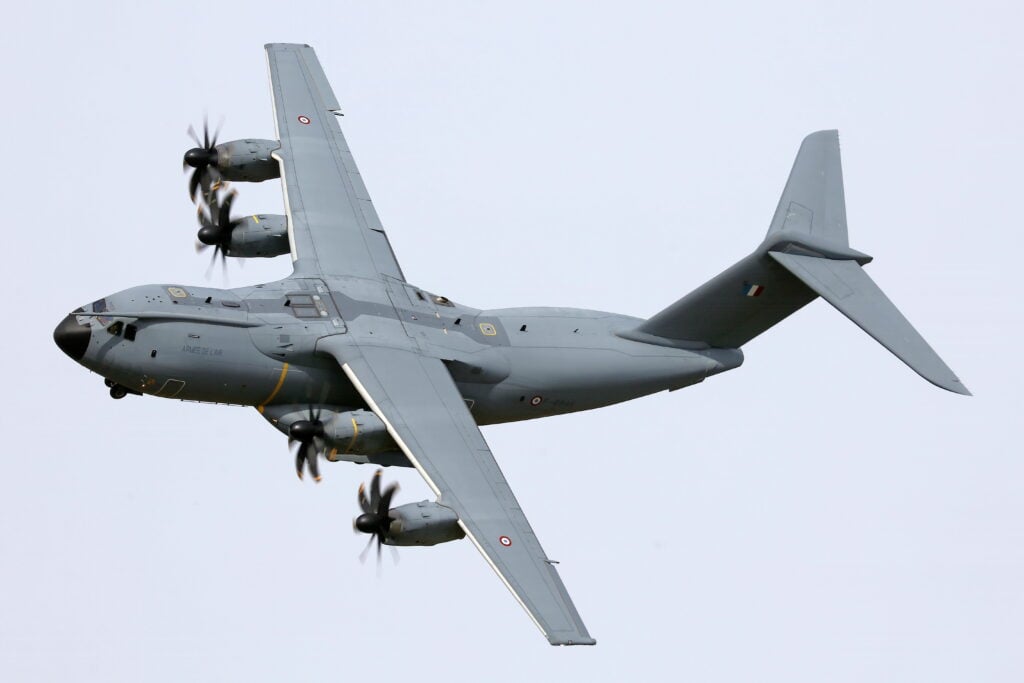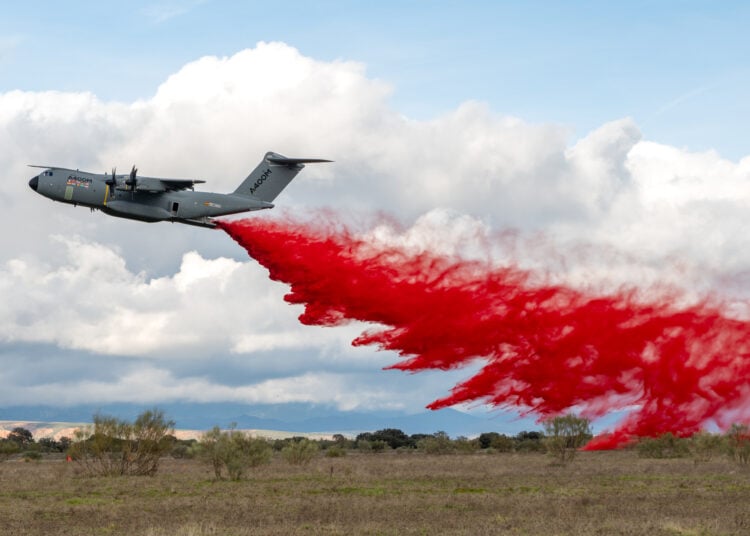Over 50 years have passed since the introduction of the Modular Airborne Fire Fighting System (MAFFS), a self-contained unit used for aerial firefighting for installation and use on Lockheed C-130 Hercules medium-lift tactical transport aircraft of the United States Air Force (USAF) and Air National Guard (USANG). MAFFS started a revolution in aerial firefighting which for over five decades has played an important role in fighting wildfires not just in the United States but in Latin America, Europe, Asia, and Africa. As of January 2024, over 20 out of 26 MAFFS I/IIs in 10 different countries were still operational and in use for firefighting missions.
As many European air powers have selected Airbus A400M Atlas as a replacement for their C-130 transport aircraft, subsequently some of them need a firefighting module with a similar capability of the MAFFS system to complete the aerial firefighting mission. To meet this need, Airbus Military has designed and developed its own Roll-on/Roll-off firefighting kit for installation on the aircraft. The system which is currently in testing in Spain will enable various operators of A400Ms, particularly the Spanish Air Force to use them for firefighting purposes, a similar role previously or still carried out using the C-130B/H/J aircraft around the world.

About the MAFFS I/II on C-130s
The MAFFS program was launched in the early 1970s following the lessons learned from a major wildfire that burned and destroyed hundreds of homes in Long Beach, California. Started on September 22, 1970, fires identified as the Laguna Fire, Kitchen Creek Fire, and Boulder Oaks Fire burned 175,425 acres (70,992 ha) of land through October 4, 1970. It was so massive, that the civil fleet of air tankers in the US, one of the largest fleets in the world at the time, could not compete against it. The initiation of the MAFFS program would allow the US Forest Service to utilize C-130 Hercules tactical transport aircraft from the USAF and USANG to battle wildfires as an add-on to assist civilian air tankers that couldn't do it alone.
Congress directed the USFS (Forest Service) to develop the MAFFS program in cooperation with the Air National Guard and Air Force Reserve to produce the equipment, training, and operational procedures to integrate military air tankers into the national response system. Subsequently, a Santa Clara, California-based company named FMC Corporation was contracted to design, build, and test the MAFFS system with the key objective of quick conversion of any standard C-130 into a tanker. As a result, a prototype of the system with two pressurized tanks was produced and was flight-tested in July 1971. The MAFFS prototype was later improved and then was produced by the now-defunct Aero Union.

MAFFS is a roll-in/roll-out system initially designed for installation on the C-130E/H Hercules aircraft with the capability of installation on the modern C-130J/J-30 Super Hercules aircraft later. It has a series of five pressurized fire retardant/water tanks with a total capacity of 2,700 US gallons (10,220 liters). Each MAFFS module has a pressure tank where compressed air is stored at 82.7 bar (1200 psi). In addition to the module, a master control panel installed next to the loadmaster's seat allows them to operate discharge valves. An air compressor module is also used for charging and recharging the system between the runs. MAFFS I (legacy) has a total weight of around 11,000 pounds (5,000 kg) which could be installed on C-130E/H and now C-130J/J-30 in just an hour and it takes only 8 to 12 minutes to fill its tanks with water or fire retardant.
Water or Retardant exits through two tubes of MAFFS I which extend out the C-130's cargo ramp door. The system can disperse all 10,220 L (2,700 gal) in five seconds over a fire, producing a fire line that is 60 feet (18 m) wide and a quarter mile (400 m) long.
MAFFS I's requirement for having cargo ramp doors open during airdrop of water or retardant could cause drag and also needed the system to be pressurized only on the ground after each drop. This problem was later resolved in the MAFFS II system which can discharge the retardant through a special plug in the paratroop doors on the starboard and port sides of the aircraft using S ducts. Thanks to these ducts, the ramp door now remains closed, and subsequently, the cabin remains pressurized during drops. This also reduces drag and improves the performance of the aircraft during a drop. In addition, the MAFFS II has onboard air compressors that use aircraft power to allow for in-flight tank pressurization and untethered operations with far shorter ground servicing times.
The MAFFS II system has an increased capacity of 3,000 US gallons (11,356L). Aero Union, which was contracted to design and build MAFFS II, delivered its first production unit to the USFS in July 2008. It was flight tested in August and was later used by the 302nd Airlift Wing of USAF Reserve from McClellan Tanker Base in California on an operational test using a C-130H on a fire in July 2008. The unit is currently tasked to also train other Airlift Wings operating the systems in the US.
USAF/USANG’s MAFFS operations in 2023
While the fate of several MAFFS I systems that were used by the USFS from 1973 to 2008 is unknown today, at least 16 MAFFS I's and 10 MAFFS IIs exist around the world among them eight are in use by the USFS. These systems are kept in eight different locations around the US. They are considered a ‘24-hour resource’, meaning that when activated, it is expected that it will take 24 hours for the aircraft to arrive on the scene, as the C-130s have to be pulled from their regular military duties and fitted with the MAFFS equipment. Each one of the three Airlift Wings of the USANG and the sole Airlift Wing of the USAFR capable of using these has to always have a minimum of two of their C-130s available 24/7 to provide for the USFS in case of any need for combatting the wildfires around the US.

As of January 2024, 146th AW has eight C-130J-30s in use of its 115th Airlift Squadron (AS) at the Channel Islands Air National Guard Station, Oxnard, California; 152nd AW has five C-130Hs and three C-130H-3s in use of its 192nd AS at Nevada Air National Guard Base, Nevada; 153rd AW has one C-130H and eight C-130H-3s in use of its 187th AS at Cheyenne Air National Guard Base, Wyoming; while 302nd AW has one C-130H and seven C-130H-3s in use of its 731st AS at Peterson Air Force Base, Colorado. During the fire seasons, two of the aircraft from each squadron are kept ready and available for firefighting operations. In addition to that, high visibility numbers and markings are painted on the vertical stabilizers of the aircraft for safety reasons making the firefighter aircraft easily distinguishable from regular military C-130s of the unit.
The MAFFS IIs are being activated on request of the foresters when all other civilian resources such as firefighter aircraft and helicopters have been used for fighting an ongoing wildfire and there is a need for more aerial assets. The National Interagency Coordination Center at the National Interagency Fire Center (NIFC), located in Boise, Idaho, can activate the MAFFS when all other contract air tankers are committed to incidents or initial attacks or are otherwise unable to meet requests for air operations. Once the request for MAFFS activation is approved by the national MAFFS liaison officer, it is then forwarded to the joint director of military support at the Pentagon.
In December 2023, the MAFFS program turned 50 years old in the US. In the 50th year of their use by the USAF and USANG for fighting wildfires in the US, they once again proved to be a vital asset for the USFS. To remain at their highest state of readiness for such missions, they hold and participate in firefighting exercises before every fire season. Such exercises involve one or all of the units independently or jointly to practice and prepare themselves for real operations. These exercises are being held every spring. The annual training includes classroom sessions, flying and ground operations for Air Force aircrews, civilian lead plane pilots, and support personnel from the USDA Forest Service, Bureau of Land Management, other federal agencies, and CAL FIRE.
In 2023 during the 50th year of MAFFS operations, C-130s of the USANG and USAFR assisted USFS in combating several large wildfires. In August 2023, 152nd AW and 302nd AW each had one of their C-130s deployed to Klamath Falls Airtanker Base, Oregan, to assist with wildland firefighting operations across western states during fire season 2023. In just two weeks they accomplished 41 sorties (flying missions), dropping over 107 thousand gallons of retardant on the Wiley, Jerry Ridge, Gray fires, and many others when requested. Later, the 153rd AW relieved the 152nd AW by sending two of its C-130Hs, 92-0548 and 92-0549 to Klamath Fall on August 21.
The 146th AW, the fourth wing that is integrated into the MAFFS program also became involved in fire-fighting missions in Klamath Falls using two aircraft. In late August, the Hollywood Guard activated a support aerial fire-fighting mission in Klamath Falls involving two aircraft from the wing. On August 30, 2023, all four of the U.S. Air Force’s component MAFFS wings traversed to Klamath Falls Airtanker Base in support of wildfire suppression efforts as the MAFFS program recognized its 50th year of partnership between the Department of Defense and the U.S. Forest Service. In 2023, the extension for continued MAFFS assets in the US continued undergoing major fire incidents requiring heavy aerial firefighting tanker support with over 20,404 personnel now supporting 58 of the active large wildland fires across the continental US.
The Airbus A400M, The New Player in the Game
The Airbus A400M is the world’s second most popular medium-lift tactical transport aircraft. As of January 2024, out of 178 A400Ms ordered by nine different countries around the world 125 were delivered and operational. This made it the second most popular medium-sized tactical airlifter after C-130J Super Hercules. As of January 2024, 16 C-130Js and 236 C-130J-30s were in use by air forces of 21 countries. Some of these air forces had legacy MAFFS or MAFFS II to use on their aircraft for firefighting missions. Some others such as Brazil and Thailand which still operate older C-130s (B/H models) are still operators of MAFFS I/IIs but with the retirement and replacement of their aircraft with newer aircraft, they will need to use new firefighting modules on them as well.

Many European Air Powers have selected the Airbus A400M as a replacement for their C-130 and other medium-lift tactical transport aircraft. Some of them including France and Spain suffer from massive wildfires annually, thus they intend to use their A400Ms in the way the MAFFS program utilizes them for the Forest Service in the US. An A400M can carry 81,570 lbs of maximum payload while this is 47,399 lbs for C-130J/J-30. This made it necessary for Airbus to design and develop a new firefighting module capable of carrying larger amounts of water and retardant to meet the needs of air forces already operating A400Ms.
With the growing need for firefighting capability of medium-lift cargo aircraft of the world's air forces and as MAFFS II was integrated into Embraer C-390A Millennium for use by the Brazilian Air Force, Airbus decided to design and develop a special roll-in/roll-out module for installation on A400M. This not only could help some of its current customers and operators such as Spanish, German, and French Air Forces to utilize these aircraft for firefighting operations but also help marketing and selling it in the market.
It is not known when exactly Airbus started the work on designing the kit or module, but the prototype of the system was successfully tested in Getafe, Spain on July 26, 2022. For this test, Airbus used the sixth manufactured A400M to carefully inspect and monitor the airdrop of water, a Casa C-101 advanced training jet (54-21) of the Spanish Air Force was used as chase aircraft to fly next to it and also to film the airdrop of water during the test. The test campaign took place in daylight conditions with a minimum operating height of 150ft, flight speeds as low as 125 knots, and drops totaling over 15,000 gallons of water during testing. The main objective of the campaign was to validate the drop water quantity and time as well as the ability of the A400M to carry out this new role with the kit.
Interestingly, the 43rd Group of the Spanish Air Force, a current operator of Bombardier CL-215T/415s, helped Airbus in the design and development of this prototype. Similar to MAFFS, the kit is a roll-on/roll-off (RORO) that requires no modification to the aircraft and therefore is interchangeable with any aircraft in the A400M fleet. The water is stored in a fixed tank in the cargo hold, and retained by two independent doors. These doors are connected to two flood pipes, so when the discharge is triggered, the water is expelled through two sections at the end of the ramp. The introduction of this RORO solution allows a rapid reaction to unforeseen fires and reconfiguration of the aircraft to any of its other roles. Due to its low-level flight capability and maneuverability at low speeds, the A400M can accurately drop payloads of water at very low heights, down to 150ft.
Airbus Defence later began working on improving the system and also developed plans for making A400M operators become capable of airdropping water at night to make A400M superior to MAFFS-equipped C-130s in such missions. The improved kit was made available for trials in November 2023. Airbus Defence and Space conducted a new flight-test campaign of the A400M Roll-on/Roll-off firefighting prototype kit, dropping 20,000 liters/5,000 Gallons of retardant and creating high concentration lines over 400 meters long on the ground. Over two weeks, the A400M carried out ground and flight-test campaigns in southwestern and central Spain, including six drops, three of which used retardant and three using water. During the new campaign, the 43rd Firefighting Squadron of the Spanish Air Force assisted as technical advisors.

“We have tested a new version of the kit, improving dropping efficiency and reducing discharge time by over 30% compared to last year, while combined with rapid deployment and easy installation on the A400M aircraft,” said Jean-Brice Dumont, Head of Military Air Systems at Airbus Defence and Space. “We continue to pioneer new solutions and capabilities for our A400M fleet, in this case protecting populations and natural environments from fires.”
It is not exactly known yet how many tanks the kit has and how its pressurization system works but similar to MAFFS I, it requires the aircraft to have its ramp door open as the water/retardant discharge pipes of the aircraft should be positioned on the lower section of that door. It is known that the kit has a mechanical lever that allows a door to open, allowing a gravity-fed drop from the tanks Similar to MAFFS, it takes less than 10 minutes using standard high-pressure pumps on the ground to fill its tanks.
Based at Torrejón near Madrid, Grupo 43 of the Spanish Air Force operates ten CL-214Ts and four CL-415s in use of its 431 Squadron for firefighting missions. During fire seasons, sometimes this fleet of aerial firefighters is only able to function at an 80% availability rate, making it necessary for the Air Force to have the option to utilize its A400Ms equipped with the kit to assist them in the future. The possibility of procurement and use of the same kit by the French Air and Space Force is currently under evaluation.
Air Forces of Malaysia and Indonesia, the current and future operators of A400M Atlas have also shown interest in the program which if procured for their A400Ms, will allow those countries to more effectively battle massive wildfires that have become more prevalent in the area over the past several years. Mass production of the firefighting kit will also help Airbus in marketing its A400M as a more capable multi-mission aircraft in the future as many countries that suffer from wildfire annually may consider the firefighting capability of A400M as a bonus factor for buying it as a replacement for their older tactical transport aircraft.






